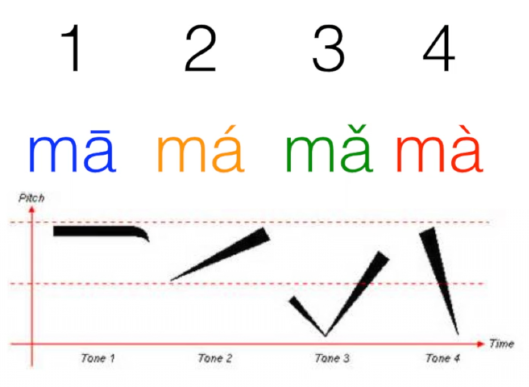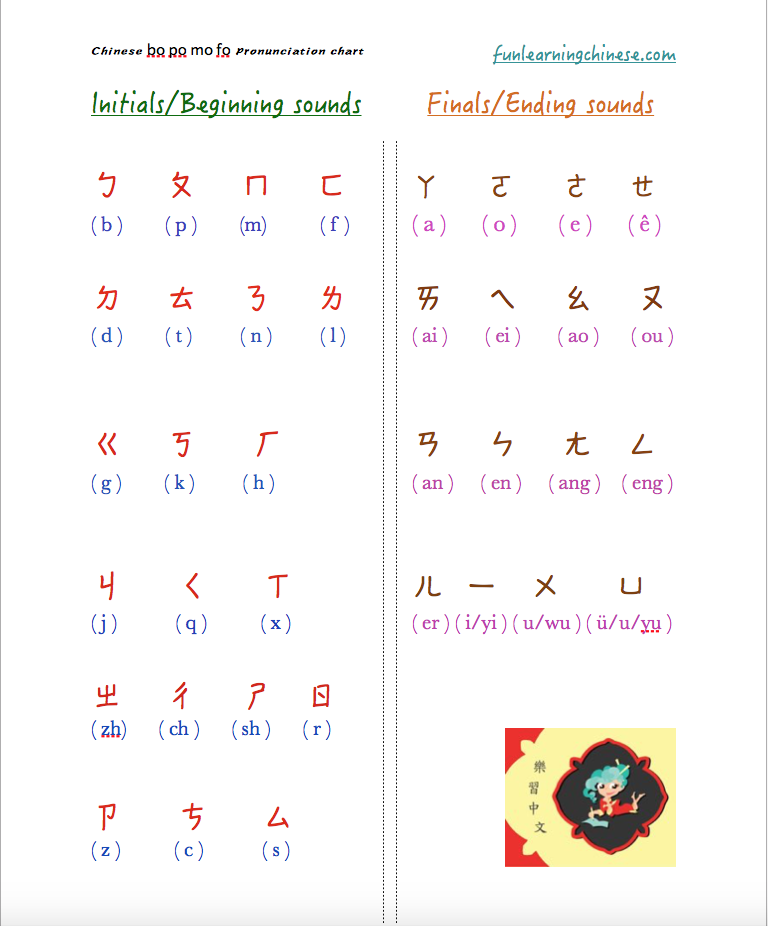After learning Chinese Mandarin for over 10 years. I feel I should write a guide on how to pronounce Mandarin and so give something back to the language learning community. This guide will go over all the pronunciations for specifically Taiwanese Mandarin but it’s about 90% the same as mainland China. This is everything I wish I knew when I started learning.
Tones
Let’s start with the hardest part – but don’t think impossible to learn, just it will take more time. You probably heard Mandarin has four tones. See the picture below:
 There is also a 5th neutral tone
There is also a 5th neutral tone
Each character in Chinese has a tone, and sometimes multiple tones, but this isn’t the right way to think about it. Because when speaking Chinese your meaning involves two components, the pronunciation and the tone. These two things together creates a word and therefore meaning. This is the most important thing to remember.
This is completely different to English. Where in English your pronunciation is the meaning (usually) and your tone gives feeling.
For example, if I say: today was a great day or today was a greaaaaat day. The meaning is the same but the tone is different, this emphasizes my feeling. Chinese does not work this way. Your tone and pronunciation is intrinsic, it’s always together and can’t be changed.
English also has tones, an other example: All board! or all aboard? The question mark changes the meaning of the sentence, and when reading this question out, you’ll do an upward inflection – this is a tone. This is natural and you don’t even think about it. Chinese is a lot like this, but there are four tones and each word has it’s own special tone.
So when learning Chinese think in terms of tone and pronunciation together, the best way to do this is by hearing and repeating or else you’ll never pronounce anything right.
I’ll also take this opportunity to explain because of tones being meaning. Mandarin speakers do not convey their feelings through tones like we do. This is why Mandarin speakers speaking English have this kind of deadpan tone in their voice, it’s not natural to convey meaning with tones. Instead to convey feeling in Chinese you would use a Chinese particle ie: 吧,啊,耶,啦.
Consequently, this means there is no exaggeration and sarcasm in the language because the tone is part of your meaning, not your feeling. Yes, you can still do these things with your friends etc but in Chinese people always speak accurately. Exaggeration and sarcasm both rely 90% on tone so they generally don’t work unless very obvious.
A commonly confused word is 為. If you look it up you’ll get multiple different definitions, it’s because this word has two meanings depending on the tone. Remember the tone is the meaning, so when you hear it or read it. You need to know the tone being used, if you’re ever confused just ask someone to pronounce it for you. In Chinese a big issue with the language is you can’t pronounce a word just by looking at it and you also don’t know the tone.
So 為 has two meanings, wèi (fourth-time) and wéi (second-tone). Remember the tone is part of the meaning. So wèi means for and wéi means to be. This is just one example but they are everywhere, example: 更 gèng (more) or 更 gēng (to change or replace). This explains why 更新 means to renovate and not more new. This is also why 更衣室 means change clothes room, not more clothes room.
One more example for people in Taiwan. A common way to save your receipt is to 載具, the dictionary will write this as zài jù but it’s not that zài (to carry), it’s actually the third-tone zǎi (to record).
Note: This is what makes Chinese hard to learn online because a lot of flashcards or pinyin has the wrong tone causing confusion. Keep this in mind.
Bottom line: remember the tone and pronunciation always goes hand in hand.
First Tone (Deadpan Tone)
This is the deadpan tone, act like you have no emotion and go higher in volume. But you’re not singing, I see a lot of people try to sing this. It’s just a normal voice without any variation in tone. Like a zombie.
Just remember: no emotion.
Second Tone (Question Tone)
This is the question tone. It can feel strange because you feel like you’re asking a question but you’re not. Start at a normal tone and then quickly go up. Don’t go too slowly.
Just remember: you’re asking a question.
Third Tone (Annoyed Tone)
This one is probably the trickiest because it’s hard to hear. But this is the tone a teenager would make when they are annoyed. Imagine your mom is calling you and you’ll say What?! or YeaaaHHH.
For this you start as low as you can until you reach your limit, and because you’re so low you kinda naturally go up in tone. As you pronounce just keep letting the tone go up.
Just remember: start low, end high.
Fourth Tone (Angry Tone)
This one seems easy but people will kinda hold back because they feel the tone is too angry and that’s not good. Remember tones are meaning not feeling. Pronounce this like you’re angry and go straight down.
Just remember: you’re angry.
Fifth Tone (Quick Tone)
This is a character that is pronounced quicker than the others and doesn’t have a distinct tone. This is typically used for common daily words and is always the last character in the word, ie 媽媽 māma. I should note in Taiwan this is rarely used, it’s only seen for family names.
Just remember: quick pronunciation.
Tone Changing
Ok, sometimes because tones sound weird or unnatural the tone gets changed. This is kinda like in English you won’t say “a elephant” or “can’t”. “An elephant” is said because two vowels together doesn’t sound good and “cannot” is used because “can’t” is hard to hear clearly. Languages are built on listening first and then written down after the fact, which is why these things happen.
一 (yī)
Normally this is the first tone (and always is when counting, ie 第一個) but if it’s paired with anything else. It will swap to a second tone (question tone) or a fourth tone (angry tone). This is because it sounds nicer. Here is an article that goes into more depth.
The key take away here is don’t say yīyàng, instead say yíyàng.
不 (bù)
Samething as above.
The key take away here is don’t say bùyào, instead say búyào.
Double Third Tone (Annoyed Tone)
If two third tones appear beside each other. The first third tone becomes a second tone (question tone). This is because it’s just easier to pronounce.
Example from the link above: 很 (hěn) 好 (hǎo): (hén hǎo) means very good.
Practicing
For practicing I recommend getting a mic that can let you record as you speak. And try to mimic other people. This is called shadowing.
That’s all for tones! Everything after is much easier.
Pronunciation
Let’s start making words.
 All the pronuncations in Chinese
All the pronuncations in Chinese
To make a word in Chinese you will take one consonant from the left and one vowel (or more) from the right. It’s not as bad as it looks.
If you want to hear the sounds I recommend this site.
Emphasize Each Character
Chinese speakers think and read each character at a time. It’s not like English where you can kinda mumble whole words together. People need to hear your tone, you’re obivously learning, so speak slowly and clearly. I’ve seen plenty of native speakers speak really slowly and there is nothing wrong with that.
Like we learned before, tones are meaning – they can’t give feeling with tone, so people speaking Chinese will typically emphasize by speaking characters slower. This really drills home their feeling. It’s just a different way of communicating.
Just remember: spend like 200ms on each character and emphasize the tone.
Initials
The top three rows of initials (b, p, m, f, d, t, n, l, g, k, h) are similar enough to English. I’ll dive into the more difficult ones.
J / Q / X
For these but your tongue under your bottom teeth. J is like saying jeez but a lot stronger. Q is similar but it’s like chee. X is like shee.
Just remember: Tongue below bottom teeth and have a strong ee sound.
Zh / Ch / Sh / R
Tongue position is on the roof of your mouth.
Zh actually has a d sound infront, it’s more like dzher.
Ch is like cher.
Sh is like Sure.
R is the ending of sure, so it sounds like re.
Z / C / S
Z sounds like dz.
C sounds like ts (like in cats).
S sounds like (si).
Endings
A sounds like f-a-ther.
O sounds like owa. But heavier oh sound.
E sounds like u in put plus u in duh.
Second E sounds like a rapper, yeeee.
AI sounds like aye aye captian but heavier.
EI sounds like ehhh but heavier.
AO sounds like when you hit your knee. Aaaooouuu.
OU sounds like ooooh in English but heavier.
AN / EN / ANG / ENG
Most people can’t hear the difference between these but there is one. The an / en sounds are at the front of the mouth, think “gun”. The ng is used to show the sound comes from the back of your throat, think “lung”. Say these words a few times and you’ll see the sound is made differently.
Core Endings
These endings are used in many words. The way pinyin is written doesn’t show the actually pronunciation. When you see a compound word like “chuang”, it is actually “ch-wu-ang”. Learn the core pronunciations and then just combine them together. An other is “qiong”, it’s actually “q-yi-yong”. Zuan is actually “dz-wu-an”. Quan is actually “qv-en”, ignore the an, it’s actually en. Tian is actually “t-yi-en”.
The only exception is the -ong ending, like zhong is actually “dzh-own”, it’s not like “yong”.
Yi
Flat tongue, sounds like ee. Whenever you see an i or yi, always think “ee”. For example: Qiang is actually qee-ang, Bi is bee, yin is yeen (like in teen).
U / WU
This always pronounced as “oo”, like boo or when you see someone get hurt, you’ll say “ooooo”. It’s really deep and long. Whenever you see a wu or u it’s always pronounced as oo. For example: zhuan is dzh-oo-an, weng is oo-eng, zu is dz-oo.
Yu / Yv
This sound doesn’t exist in English. Start with a flat tongue and saying eee, then round your lips. You’ll make the “v” sound or u with two dots on top.
Yuan
This is probably the hardest sound. Ignore the “an”, it’s always “en”. It’s “yv-en”, start with yv and then quickly end it with en. You should see a transition happen.
Yun
This a little tricky but start with “yv” and then end it with a “een” sound like “teen”.
Taiwanese Pronunciation
Taiwanese people don’t curl the tongue, so shi and si sound the same. Also yin / ying sound the same.